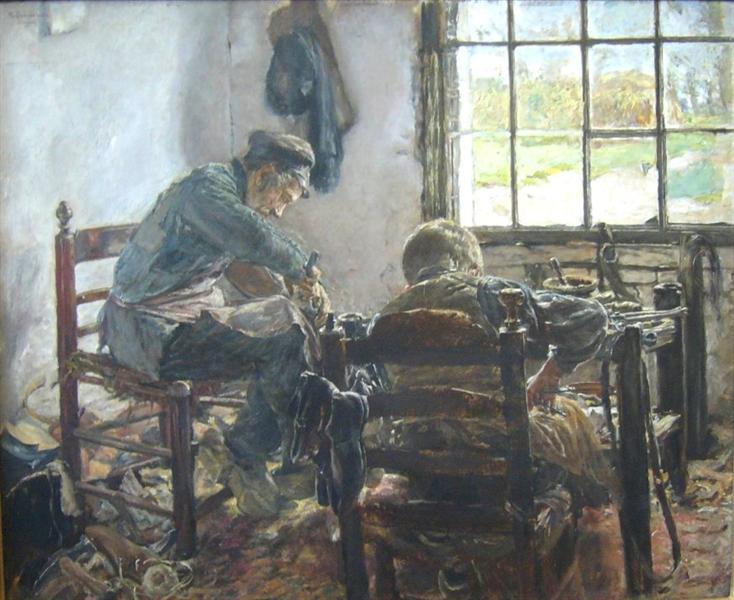Descriere
Lucrarea „Zapatero” a lui Max Liebermann, creată în 1881, este un exemplu reprezentativ al abordării artistului la realism, infuzat cu coloranți impresionisti care marchează stilul său distinctiv. Liebermann, un pictor german proeminent, a intrat în reprezentarea vieții de zi cu zi și a claselor muncitoare, probleme care au devenit subiecte recurente în producția sa artistică. În acest tablou, artistul surprinde figura unui cizmar cufundat în munca sa zilnică, oferind o fereastră lumii muncii manuale.
Atunci când observați compoziția „Zapatero”, există un domeniu remarcabil în dispoziția spațiului și a figurii. Cizmarul apare în prim -plan, izolat în atelierul său, care este prezentat ca un mediu intim și personal. Acesta evidențiază munca sa printr -o abordare care mișcă proximitatea și căldura pe care o transmite. Figura este cufundată în sarcina sa, ceea ce reflectă atât dăruirea, cât și mândria care poate apărea în exercitarea comerțului. Postura sa, înclinată înainte, indică concentrarea, în timp ce lumina care intră prin fereastră creează un efect aproape teatral care evidențiază intimitatea acesteia.
Utilizarea culorii în această lucrare este fundamentală. Liebermann folosește o paletă bogată și nuanțată, cu tonuri calde de maro și ocru care evocă rusticitatea atelierului, contrastând cu cele mai clare tonuri care radiază de pe fereastră. Această delimitare subtilă între lumină și umbră nu numai că dă viață figurii cizmarului, dar stabilește și un mediu de seninătate și efort, o reprezentare a demnității muncii. Textura vopselei, care pare aproape palpabilă în reprezentarea instrumentelor și a pielii utilizate, îmbunătățește veridicitatea scenei și conectează privitorul cu comerțul.
În ceea ce privește tehnica, „Zapatero” dezvăluie stăpânirea lui Liebermann în periajul liber și expresiv, tipic impresionismului, care permite elementelor tabloului să fie percepute ca organice și lichide. Acest mod de abordare a picturii invită privitorul să aprecieze nu numai munca terminată, ci și procesul din spatele acestuia. Influența profesorilor impresionisti devine evidentă, dar Liebermann își infuzează propria viziune, care combină obiectivitatea realismului cu sensibilitatea impresionismului.
Deși „Zapatero” nu are o narațiune complexă sau dramatică, puterea ei constă în simplitatea temei sale. Liebermann împărtășește cu privitorul o reprezentare cinstită a muncii manuale, răsunând tensiunile sociale ale vremii sale, unde industrializarea a schimbat rapid dinamica muncii în Europa. În acest sens, lucrarea poate fi citită ca o sărbătoare a vieții de zi cu zi și un tribut adus celor care o dețin, adesea invizibili în panorama artistică a timpului său.
Lucrarea este introdusă într -un corpus mai larg de lucrări în care Liebermann a abordat probleme similare. Picturile de genul „The Seamstress” și „Viața în mediul rural” reflectă aceeași atenție detaliilor și vieții oamenilor oamenilor. Cu toate acestea, „Zapatero” se remarcă pentru abordarea sa unică într -un comerț specific, comunicând nu numai actul de a crea, ci și mediul care înconjoară această lucrare, făcând din această piesă o lucrare profund umană și evocatoare în reprezentarea sa zilnic a lucrării.
În rezumat, „Zapatero” de Max Liebermann este o mărturie puternică a capacității sale de a îmbina realitatea cu emoția, creând o lucrare care transcende timpul și vorbește universalitatea efortului uman. Prin această lucrare, spectatorul poate intra în lumea cizmarului, înțelegând dedicația sa și găsind frumusețe în actul de lucru.
KUADROS ©, o vopsea faimoasă pe peretele tău.
Picturi de ulei realizate manual, cu calitatea artiștilor profesioniști și sigiliul distinctiv al KUADROS ©.
Imagini Serviciu de reproducere cu garanție de satisfacție. Dacă nu sunteți complet mulțumit de replica tabloului dvs., vă rambursăm banii 100%.

